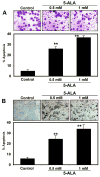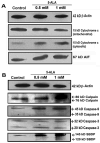5-Aminolevulinic acid-based photodynamic therapy suppressed survival factors and activated proteases for apoptosis in human glioblastoma U87MG cells
- PMID: 17335970
- PMCID: PMC2533742
- DOI: 10.1016/j.neulet.2007.01.071
5-Aminolevulinic acid-based photodynamic therapy suppressed survival factors and activated proteases for apoptosis in human glioblastoma U87MG cells
Abstract
Glioblastoma is the most common astrocytic brain tumor in humans. Current therapies for this malignancy are mostly ineffective. Photodynamic therapy (PDT), an exciting treatment strategy based on activation of a photosensitizer, has not yet been extensively explored for treating glioblastoma. We used 5-aminolevulinic acid (5-ALA) as a photosensitizer for PDT to induce apoptosis in human malignant glioblastoma U87MG cells and to understand the underlying molecular mechanisms. Trypan blue dye exclusion test showed a decrease in cell viability after exposure to increasing doses of 5-ALA for 4h followed by PDT with a broad spectrum blue light (400-550 nm) at a dose of 18J/cm(2) for 1h and then incubation at 37 degrees C for 4h. Following 0.5 and 1mM 5-ALA-based PDT (5-ALA-PDT), Wright staining and ApopTag assay showed occurrence of apoptosis morphologically and biochemically, respectively. After 5-ALA-PDT, down regulation of nuclear factor kappa B (NFkappaB) and baculovirus inhibitor-of-apoptosis repeat containing-3 (BIRC-3) protein indicated inhibition of survival signals. Besides, 5-ALA-PDT caused increase in Bax:Bcl-2 ratio and mitochondrial release of cytochrome c and apoptosis-inducing factor (AIF). Activation of calpain, caspase-9, and caspase-3 occurred in course of apoptosis. Calpain and caspase-3 activities cleaved alpha-spectrin at specific sites generating 145kD spectrin breakdown product (SBDP) and 120kD SBDP, respectively. The results suggested that 5-ALA-PDT induced apoptosis in U87MG cells by suppression of survival signals and activation of proteolytic pathways. Thus, 5-ALA-PDT can be an effective strategy for inducing apoptosis in glioblastoma.
Figures




Similar articles
-
Molecular mechanism of inositol hexaphosphate-mediated apoptosis in human malignant glioblastoma T98G cells.Neurochem Res. 2007 Dec;32(12):2094-102. doi: 10.1007/s11064-007-9369-y. Epub 2007 Jul 7. Neurochem Res. 2007. PMID: 17616815
-
Curcumin suppressed anti-apoptotic signals and activated cysteine proteases for apoptosis in human malignant glioblastoma U87MG cells.Neurochem Res. 2007 Dec;32(12):2103-13. doi: 10.1007/s11064-007-9376-z. Epub 2007 Jun 12. Neurochem Res. 2007. PMID: 17562168
-
Curcumin activated both receptor-mediated and mitochondria-mediated proteolytic pathways for apoptosis in human glioblastoma T98G cells.Neurosci Lett. 2006 Oct 16;407(1):53-8. doi: 10.1016/j.neulet.2006.08.013. Epub 2006 Sep 1. Neurosci Lett. 2006. PMID: 16949208
-
Experimental use of photodynamic therapy in high grade gliomas: a review focused on 5-aminolevulinic acid.Photodiagnosis Photodyn Ther. 2014 Sep;11(3):319-30. doi: 10.1016/j.pdpdt.2014.04.004. Epub 2014 Jun 4. Photodiagnosis Photodyn Ther. 2014. PMID: 24905843 Review.
-
Three Decades of Photodynamic Therapy for Glioblastoma: A Comprehensive Scientometric Analysis.Photodiagnosis Photodyn Ther. 2025 Jun;53:104533. doi: 10.1016/j.pdpdt.2025.104533. Epub 2025 Mar 5. Photodiagnosis Photodyn Ther. 2025. PMID: 40054646 Review.
Cited by
-
Role of ER stress response in photodynamic therapy: ROS generated in different subcellular compartments trigger diverse cell death pathways.PLoS One. 2012;7(3):e32972. doi: 10.1371/journal.pone.0032972. Epub 2012 Mar 5. PLoS One. 2012. PMID: 22403731 Free PMC article.
-
Molecular mechanism of inositol hexaphosphate-mediated apoptosis in human malignant glioblastoma T98G cells.Neurochem Res. 2007 Dec;32(12):2094-102. doi: 10.1007/s11064-007-9369-y. Epub 2007 Jul 7. Neurochem Res. 2007. PMID: 17616815
-
Photodynamic Priming Overcomes Per- and Polyfluoroalkyl Substance (PFAS)-Induced Platinum Resistance in Ovarian Cancer†.Photochem Photobiol. 2023 Mar;99(2):793-813. doi: 10.1111/php.13728. Epub 2022 Nov 7. Photochem Photobiol. 2023. PMID: 36148678 Free PMC article.
-
Curcumin suppressed anti-apoptotic signals and activated cysteine proteases for apoptosis in human malignant glioblastoma U87MG cells.Neurochem Res. 2007 Dec;32(12):2103-13. doi: 10.1007/s11064-007-9376-z. Epub 2007 Jun 12. Neurochem Res. 2007. PMID: 17562168
-
Modes of Cell Death Induced by Photodynamic Therapy Using Zinc Phthalocyanine in Lung Cancer Cells Grown as a Monolayer and Three-Dimensional Multicellular Spheroids.Molecules. 2017 May 16;22(5):791. doi: 10.3390/molecules22050791. Molecules. 2017. PMID: 28509858 Free PMC article.
References
-
- Peng Q, Warloe T, Berg K, Moan J, Kongshaug M, Giercksky KE, Nesland JM. 5-Aminolevulinic acid-based photodynamic therapy: Clinical research and future challenges. Cancer. 1997;79:2282–2308. - PubMed
-
- Henderson BW, Dougherty TJ. How does photodynamic therapy work? Photochem Photobiol. 1992;55:145–157. - PubMed
-
- Grebenova D, Kuzelova K, Smetana K, Pluskalova M, Cajthamlova H, Marinov I, Fuchs O, Soucek J, Jarolim P, Hrkal Z. Mitochondrial and endoplasmic reticulum stress-induced apoptotic pathways are activated by 5-aminolevulinic acid-based photodynamic therapy in HL-60 leukemia cells. J Photochem Photobiol B. 2003;69:71–85. - PubMed
-
- Wild PJ, Krieg RC, Seidl J, Stoehr R, Reher K, Hofmann C, Louhelainen J, Rosenthal A, Hartmann A, Pilarsky C, Bosserhoff AK, Knuechel R. RNA expression profiling of normal and tumor cells following photodynamic therapy with 5-aminolevulinic acid-induced protoporphyrin IX in vitro. Mol Cancer Ther. 2005;4:516–528. - PubMed
-
- Kriska T, Korytowski W, Girotti AW. Role of mitochondrial cardiolipin peroxidation in apoptotic photokilling of 5-aminolevulinate-treated tumor cells. Arch Biochem Biophys. 2005;433:435–446. - PubMed
Publication types
MeSH terms
Substances
Grants and funding
LinkOut - more resources
Full Text Sources
Medical
Research Materials

